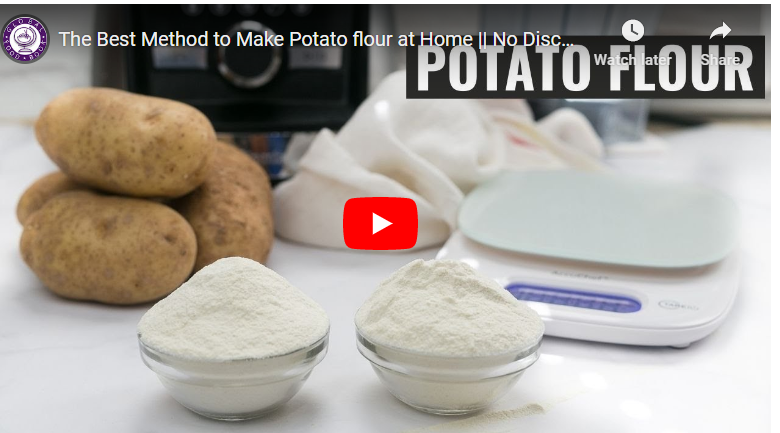Flour is a staple ingredient in many of our daily meals and baked goods, from bread and pasta to cakes and cookies. Despite its ubiquitous presence in our kitchens, the process of turning wheat into flour remains a mystery to many.
Understanding how wheat is processed into flour can help us appreciate the effort that goes into producing this essential ingredient and make informed choices when purchasing and using different types of flour.
Processing wheat into flour is a multi-step process that begins with harvesting the wheat and ends with sifting the flour. The first step is to harvest the wheat and separate it from the chaff, which is the inedible outer shell of the wheat. Next, the wheat is crushed and ground into a powder-like consistency.
The wheat powder is then sifted through a sieve to separate the bran and germ from the endosperm. Finally, the endosperm is milled into flour. With a few simple steps, you can process wheat into flour and use it to bake breads, cakes, and other delicious dishes.
How To Process Wheat into Flour Step By Step Guide
Whether you’re a professional baker or a home cook, understanding the wheat-to-flour process can help you achieve better results in your recipes and make more informed choices when selecting flour.
So, let’s dive in and explore the fascinating world of flour production.
Read Also: How To Process Soyabeans
Stage I. Preparing the Wheat for Milling
Before the wheat can be milled into flour, it needs to be prepared by following these steps:
Step 1 – Cleaning And Removing Impurities
- Begin by sorting through the wheat berries and removing any debris, such as stones, dirt, or chaff.
- Then, use a fan or a vibrating sieve to remove any lighter materials, such as dust, straw, and broken seeds.
- Finally, use a magnetic separator to remove any iron or steel particles that may have gotten mixed in with the wheat.
Read Also: How To Process Poundo Yam Flour
Step 2 – Conditioning The Wheat For Optimal Milling
Wheat that is too dry or too moist can affect the milling process and the quality of the flour produced.
To condition the wheat, you can use a process called tempering, which involves adding moisture to the wheat and allowing it to rest for a period of time.
The amount of moisture and the length of time for tempering will depend on the type of wheat and the desired flour type.
Read Also: How To Process Potatoes Flour
For example, hard wheat may require longer tempering than soft wheat, and whole wheat may require less moisture than white flour.
Stage II. Milling the Wheat
After the wheat has been cleaned and conditioned, it’s time to mill it into flour. Here’s how you can do it:
The milling process involves grinding the wheat into smaller particles to separate the bran, endosperm, and germ. The type of mill used will determine the particle size and consistency of the flour produced.
There exist two primary categories of mills, namely stone mills and roller mills.
Stone Mills
Stone milling is a traditional method of milling wheat that has been used for centuries to produce high-quality flour with a distinctive flavor and texture. Here’s how you can use a stone mill to turn wheat into flour:
Read Also: How To Process Plantain Flour
Step 1: Setting Up The Stone Mill
Begin by setting up the stone mill according to the manufacturer’s instructions. This may involve assembling the mill, attaching it to a motor, and adjusting the milling settings to achieve the desired particle size and consistency.
Step 2: Cleaning and Preparing The Wheat
Before milling the wheat, make sure to clean and prepare it by removing any debris, such as stones, dirt, or chaff, and conditioning it for optimal milling.
Step 3: Milling the Wheat
Once the wheat is prepared, feed it into the stone mill and let the mill do its work. The mill will grind the wheat between two large, heavy stones, separating the bran, endosperm, and germ to produce flour.
Read Also: How To Process Pepper
Step 4: Sieving and Bolting the Flour
After milling, sift the flour through a series of sieves to remove any remaining impurities and to separate the flour into different grades based on particle size.
For the finest flour, you can use a bolting cloth or a series of silk or nylon screens to remove the smallest particles.
Step 5: Storing the Flour
Finally, store the flour in a cool, dry place in an airtight container to maintain its freshness and quality. Make sure to use the flour within the recommended time frame to ensure optimal flavor and nutritional value.
Read Also: How To Process Palm Kernel Oil
Note that by following these steps, you can produce high-quality flour using a traditional stone mill. While this method may require more time and effort than using a roller mill, the unique flavor and texture of the flour produced make it well worth the extra effort.
Roller Mills
Roller milling is a modern method of milling wheat that is commonly used in commercial flour production. Here’s how you can use a roller mill to turn wheat into flour:
Step 1: Cleaning And Preparing The Wheat
Begin by cleaning and preparing the wheat, removing any debris, such as stones, dirt, or chaff, and conditioning it for optimal milling.
Read Also: How To Process Okpa Flour
Step 2: Breaking The Wheat Into Particles
Next, the wheat is broken down into particles using a series of rollers that apply pressure to the wheat as it passes through the mill. The rollers are designed to separate the bran, endosperm, and germ to produce flour.
Step 3: Sifting The Flour
After milling, the flour is sifted through a series of sieves to remove any remaining impurities and to separate the flour into different grades based on particle size.
Step 4: Purifying The Flour
For certain types of flour, such as white flour, additional steps may be taken to purify the flour further. This may involve treating the flour with chemicals, such as chlorine or benzoyl peroxide, to improve its color and baking properties.
Read Also: How to Process Millet into Flour
Step 5: Packaging And Storing The Flour
Finally, the flour is packaged and stored in a cool, dry place in an airtight container to maintain its freshness and quality. Make sure to use the flour within the recommended time frame to ensure optimal flavor and nutritional value.
Note that by following these steps, you can produce high-quality flour using a modern roller mill. While this method may not produce the same unique flavor and texture as stone milling, it is a highly efficient and effective method of milling wheat on a large scale.
Read Also: How To Process Maize Into Flour
Stage III: Additional Processing Steps
Once the wheat has been milled into flour, there are several additional processing steps that can be taken to improve the quality and nutritional value of the flour. Here’s what you need to know:
Bleaching And Maturing The Flour
- Bleaching flour is a process that involves treating the flour with chemicals, such as chlorine or benzoyl peroxide, to improve its color and baking properties.
- While bleaching can make the flour whiter and easier to work with, it can also remove some of the nutrients and affect the flavor.
Read Also: How To Process Coconut Oil
Fortifying With Vitamins And Minerals
- Fortifying flour is a process that involves adding vitamins and minerals to the flour to improve its nutritional value.
- In some countries, such as the United States, flour is commonly fortified with folic acid, iron, and other nutrients to help prevent birth defects and other health problems.
Read Also: How To Process Cassava to Garri
Benefits of Processing Wheat to Flour
Processing wheat into flour offers several benefits, including:
#1. Nutritional Value
Flour is a good source of carbohydrates, fiber, and protein, making it an important part of a balanced diet.
#2. Convenience
Flour is a versatile ingredient that can be used to make a wide variety of foods, from bread and pasta to cakes and cookies.
#3. Long Shelf Life
Flour has a long shelf life when stored properly, making it a useful ingredient to have on hand for cooking and baking.
Read Also: How To Process Cashew Nuts At Home
Challenges of Processing Wheat to Flour
Despite the benefits of processing wheat into flour, there are also some challenges to consider, such as:
#1. Quality Control
Maintaining consistent quality in flour production can be challenging, particularly in larger-scale operations.
#2. Equipment Costs
The cost of purchasing and maintaining milling equipment can be significant, particularly for traditional stone mills.
Read Also: How To Preserve Spring Onions For Long Time Storage
#3. Environmental Impact
Flour production can have a significant environmental impact, particularly in terms of water usage and waste management.
Uses of Processed Wheat to Flour
Processed wheat flour has a wide range of uses, including:
#1. Baking
Flour is a key ingredient in many baked goods, such as bread, cakes, and pastries.
#2. Cooking
Flour can also be used as a thickening agent in sauces, soups, and stews.
Read Also: How to Preserve Yam for Long-Time Storage
#3. Snacks
Flour can be used to make a wide range of snacks, such as crackers, pretzels, and chips.
Where to Sell Wheat Flour
Processed wheat flour can be sold through a variety of channels, including:
#1. Retail Stores
Many grocery stores and specialty food shops sell flour to consumers.
Read Also: How To Preserve Watermelon For Long Time Storage
#2. Wholesale Distributors
Flour can also be sold to wholesale distributors, who then distribute it to retailers or food service providers.
#3. Online Marketplaces
Online marketplaces, such as Amazon and Alibaba, offer a platform for selling flour to a global audience.
How to Process Wheat at Home
Processing wheat at home can be a rewarding and satisfying experience. Here are some vital basic steps to follow:
Read Also: How To Preserve Water Leaf For Time Storage
#1. Cleaning
Begin by cleaning the wheat thoroughly, and removing any dirt, debris, or stones.
#2. Soaking
Soak the wheat in water overnight to soften the grains and make them easier to work with.
#3. Sprouting (optional)
To increase the nutritional value of the wheat, you can sprout the grains by rinsing them with water and allowing them to germinate for a few days.
Read Also: How To Preserve Tiger Nut For Long Time Storage
#4. Drying
Once sprouted (or if you skip that step), dry the wheat thoroughly before milling to prevent mold growth.
#5. Milling
Use a manual or electric grain mill to grind the wheat into flour.
How to Make Flour from Wheat by Hand:
If you don’t have access to a grain mill, you can still make flour from wheat by hand. Here’s how:
#1. Cleaning
Begin by cleaning the wheat thoroughly, removing any dirt, debris, or stones.
Read Also: How To Preserve Sweet Potatoes For Long Time Storage
#2. Grind By Hand
Use a mortar and pestle or a hand-cranked grinder to grind the wheat into flour. This can be a labor-intensive process and may take some time to achieve a fine, consistent texture.
How is Wheat Harvested
Wheat is typically harvested using a combine harvester, which is a large machine that cuts and threshes the wheat in one pass. Here’s how it works:
Read Also: How To Preserve Scent Leaf For Long Time Storage
#1. Cutting
The combine harvester uses a cutting blade to cut the wheat at the base of the stalk.
#2. Threshing
The machine separates the wheat grains from the stalks and husks.
#3. Cleaning
The wheat grains are then cleaned and sorted to remove any remaining debris.
Grinding Wheat into Flour is a Physical or Chemical Change
Grinding wheat into flour is a physical change because the process does not involve any chemical reactions.
Read Also: How To Preserve Ripe Plantain For Long Time Storage
The wheat grains are simply ground into smaller pieces, but their chemical composition remains the same. This is in contrast to chemical changes, where the chemical composition of a substance is altered.
Examples of chemical changes include baking bread or roasting coffee beans, where heat causes chemical reactions that transform the original ingredients into something new.
Read Also: How To Preserve Rice from Weevils
Conclusion
The process of turning wheat into flour is a complex and fascinating journey that involves a series of steps to clean, condition, and mill the wheat into different types of flour.
Understanding this process can help us appreciate the effort that goes into producing high-quality flour and make informed choices when selecting flour for our cooking and baking needs. By following the tips and techniques outlined in this article, we can ensure that we use flour effectively and store it properly to maintain its freshness and quality.



